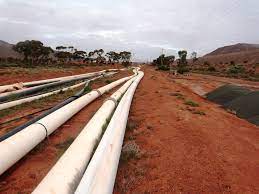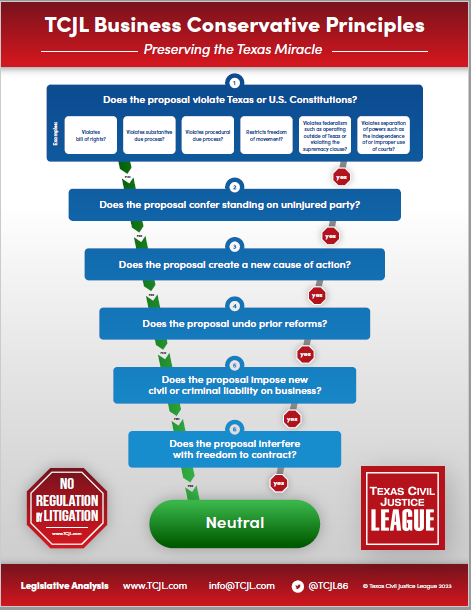 In another episode of the long-running litigation saga pitting HSC Pipeline against the Hlavinka land interests, the Houston [1st] Court of Appeals has conditionally issued HSC’s petition for writ of mandamus barring the Hlavinkas from compelling discovery of the cost, revenue, and profitability of HSC’s pipeline.
In another episode of the long-running litigation saga pitting HSC Pipeline against the Hlavinka land interests, the Houston [1st] Court of Appeals has conditionally issued HSC’s petition for writ of mandamus barring the Hlavinkas from compelling discovery of the cost, revenue, and profitability of HSC’s pipeline.
If this case sounds familiar, it should. TCJL filed two amicus briefs in the underlying case, Hlavinka v. HSC Pipeline P’ship, LLC, 650 S.W.3d, 438 (Tex. 2022), the first at the Houston [1st] Court of Appeals and the second at the Texas Supreme Court. To quickly recap the nature of the dispute, HSC filed a condemnation proceeding in a Brazoria county court at law after the company and the Hlavinkas could not agree on a voluntary sale of a pipeline easement. The trial court granted summary judgment for HSC, resulting in an appeal. The court of appeals held that HSC did not conclusively establish that it was a common carrier with the power of eminent domain and that the trial court erred in excluding Terrance Hlavinka’s testimony as to the fair market value of the condemned easement. The court held further that whether the pipeline served a public use was a fact question for the jury and that the sales of easement rights granted on the same property were admissible as some evidence of the market value of the land. Both parties sought SCOTX review.
SCOTX reversed the court of appeals on the common carrier issue, holding that the Texas Business Organizations Code §2.105 granted common-carrier eminent domain authority for a polymer-grade propylene pipeline (the Hlavinkas argued that PGP was not a “petroleum product” and thus HSC’s pipeline was private), that the question of whether a pipeline served a public use was a legal determination for the court and not a fact issue for the jury, and that HSC conclusively established public use. But SCOTX agreed with the court of appeals about Terrance Hlavinka’s valuation testimony about sales of private pipeline easements. The Court remanded the case to the trial court for determination of the fair market value of the easement.
Back in the trial court the Hlavinkas served HSC with motions to compel a corporate representative deposition and for discovery of the cost, revenue, and profitability of HSC’s pipeline. HSC objected on the basis that the requested discovery was irrelevant under the project-enhancement rule. The trial court disagreed and granted the Hlavinkas’ motions to compel. HSC sought mandamus relief from the court of appeals.
In an opinion by Justice Countiss, the court of appeals conditionally granted relief. Under SCOTX’s ruling in Hlavinka, the court stated, a landowner may “testify about sales to other carriers of pipeline easements across the Hlavinka’s property, as some evidence of the current highest and best use of the property taken.” As SCOTX indicated, a landowner’s testimony relating to a “pipeline corridor” (our language, not the Court’s) could “provide some evidence from which a factfinder could have sold to another the easement that they instead were compelled to sell to HSC.” The Hlavinkas asserted that the requested discovery, which went far beyond the landowner’s testimony, was necessary to demonstrate whether HSC received a “windfall.” The court of appeals saw through this attempt to skirt the project-enhancement rule, which, as the court pointed out, SCOTX reiterated in Hlavinka. The reason SCOTX permitted a landowner to testify as to other pipeline sales, the court observed, “was not that the easement was valuable due to HSC’s interest, but because purchasers other than HSC also valued the easement.” And in relation to that question, the Hlavinkas’ request for financial information about the profitability of HSC’s pipeline was irrelevant and inadmissible in violation of the project-enhancement rule.
We’re not sure when or if this litigation will ever end. Presumably, the Hlavinkas could take another shot at SCOTX in their effort to use private easement sales as acceptable comparable properties and to enshrine “pipeline corridors” as a special type of “highest and best use.” It should be pointed out, as we did in our brief to SCOTX in this case, that one should be careful about one asks the court for. When a common-carrier pipeline seeks an easement on rural, agricultural land, that land is generally appraised as agricultural or open-space land, not at its fair market value. The so-called “ag exemption” reduces the market value of the land by approximately 98%. Put another way, landowners with the exemption pay property taxes on only about 2% of the land’s fair market value, by far the most expansive exemption for any category of property.
What the dispute in Hlavinka and similar cases is all about is this: for absolutely understandable reasons landowners want to increase their bargaining power in dealing with common-carrier pipelines attempting to acquire right-of-way across their land. By opening up the prospect of allowing a landowner to shift the focus in a jury trial on the amount of compensation from the fair market value of agricultural property at its highest and best use as agricultural property to its value to the common carrier pipeline’s business, landowners hope that they will be able to get much better deals out of pipelines who might not want to have that kind of argument in front of a jury composed of other landowners. This is exactly why the Hlavinkas tried to get HSC’s financials on the pipeline rather than being satisfied with their own testimony about sales of other pipeline easements on their property (which may or may not be comparable sales for valuation purposes). And it is why HSC got the court of appeals just as fast as they could to stop it.
Here is the part about being careful what one asks for. Landowners seeking this kind of change to longstanding eminent domain law are walking a tightrope between claiming a gargantuan tax advantage from agricultural use while, in the eminent domain context, asserting that their property’s value should be determined as if it were commercial propertybought and sold for building and operating pipelines. It is legally possible to have it both ways, of course, but it seems very hard to argue that property valued and taxed as agricultural land can have an entirely different (and much higher) value as a pipeline corridor but still be taxed as agricultural land. If there is any “windfall” here, it goes to the landowner for getting paid off as if the easement burdened high value commercial property rather than low value agricultural property—and still taking the huge tax break to boot.












